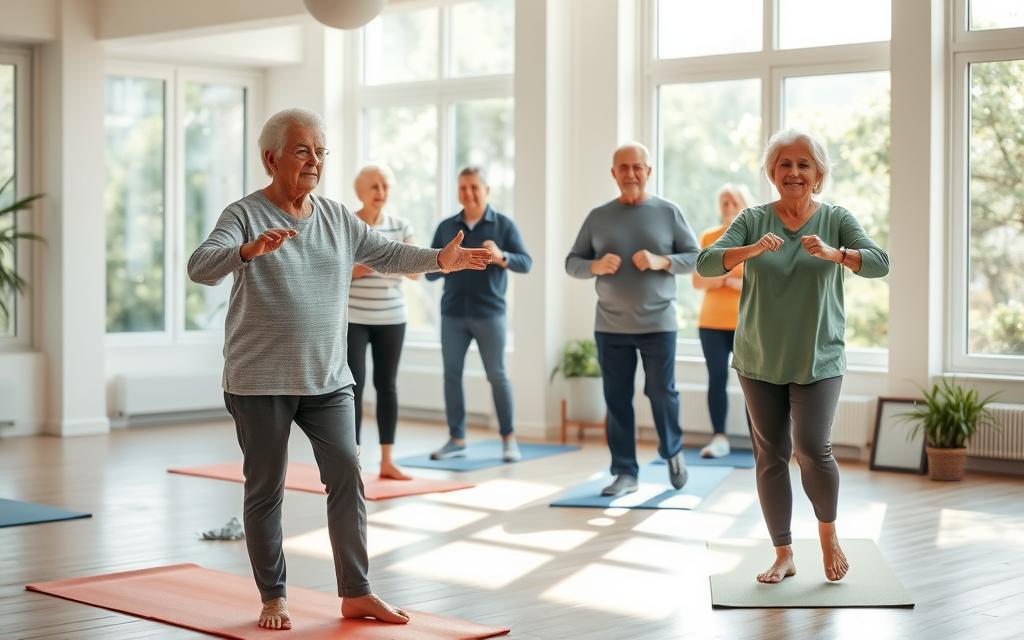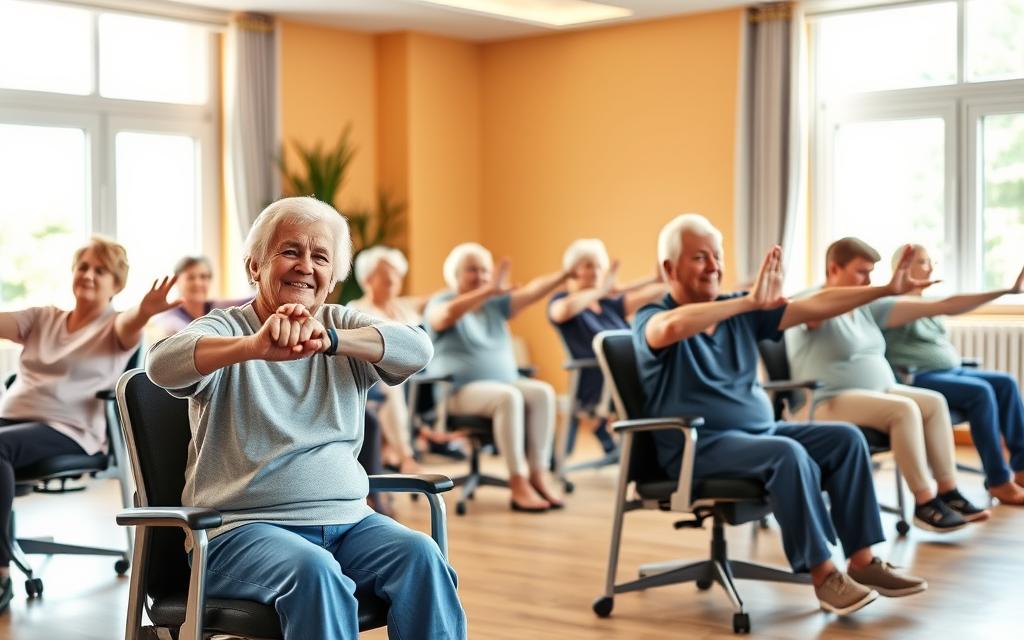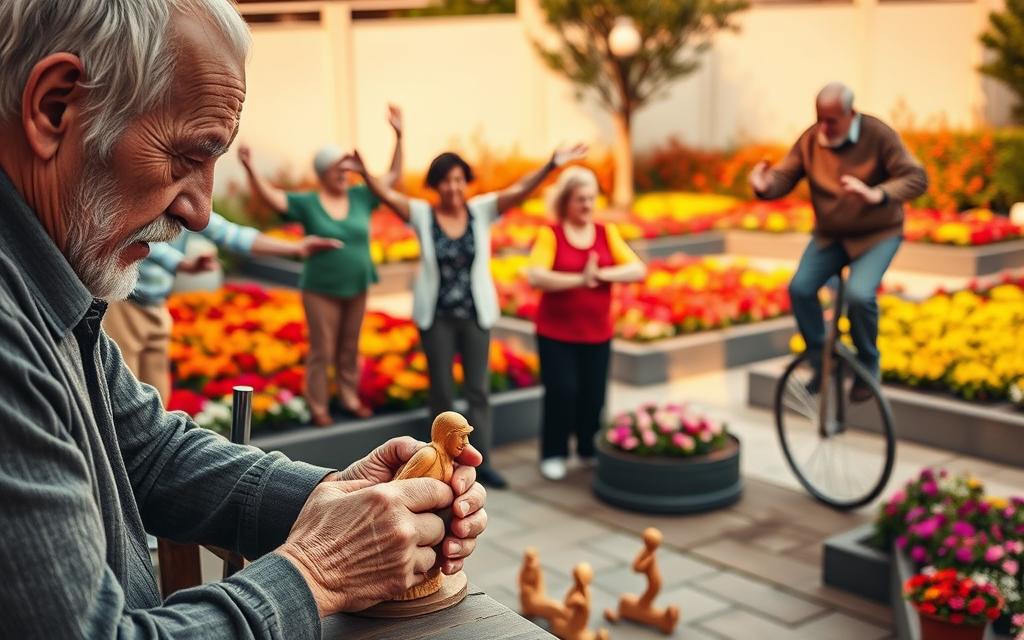Low-Impact Exercises for Seniors Over 60
Ever thought of an easy way to stay fit as you get older? Low-Impact Exercises for Seniors Over 60 are great for your joints. They remind us that gentle steps can lead to big results.
You need a plan that keeps you well. A positive attitude helps, too, when you start moving gently. Every small step keeps you active and pain-free.
Key Takeaways
- Low-impact moves reduce strain on joints.
- Maintaining mobility encourages daily comfort.
- Gentle routines can be as effective as intense workouts.
- Consistency supports independence and strength.
- A hopeful mindset fuels lasting dedication.
Low-Impact Exercises for Seniors Over 60 make fitness easy. They protect your joints, keep you flexible, and support a healthy life for years.
The Importance of Physical Activity as You Age
Staying active makes life better and keeps you healthy. It works your heart, joints, and brain. Even as you get older, it helps you stay stable and move freely.
Moving regularly can make aches and muscle tension better. It also helps you feel happier. Starting with small steps is okay. You can always do more later.
How Exercise Combats Age-Related Health Challenges
Regular exercise can help with arthritis and balance issues. It improves blood flow and reduces stiffness. Slow movements keep your joints flexible.
Exercises that help with balance can lower fall risks. They also improve how well you move and stay steady.
Recommended Activity Levels for Adults Over 60
The CDC says adults over 60 should aim for 150 minutes of moderate exercise weekly. This can be short walks or gentle stretches. Doing a little each day is best.
Choosing activities that fit your life can make you feel better. It keeps you moving without hurting your body.
Signs Your Current Routine Needs Modification
Persistent aches or tiredness might mean it’s time to change. If you’re struggling to recover, it’s a sign. Feeling out of breath or losing interest also means it’s time for a change.
Watching for these signs helps you stay safe and keep moving. It keeps you confident in your fitness journey.
Low-Impact Exercises for Seniors Over 60: Why They’re Ideal
You deserve a routine that makes you feel good without hurting your joints. Low-impact exercises are perfect for seniors. They help you stay fit without too much strain.
Your body gets used to gentle movements when you do them often. Wearing the right shoes, like Brooks or New Balance, makes walking easier and more fun.
Protecting Joints While Maintaining Fitness
Choose activities that are slow and controlled to protect your joints. Simple stretches or a walk around the block are great. They keep your heart rate up without hurting your body too much.
Reducing Chronic Pain Through Gentle Movement
Gentle exercises can help lessen chronic pain. Try light stretching to loosen up tight spots, like your lower back. Doing this regularly can help you move better and feel less pain.
Building Strength Without Risking Injury
Exercises that are not too hard can keep your muscles and bones strong. Try squats with less weight to build strength. This way, you work out without hurting your joints.
Getting Started: Creating Your Safe Exercise Plan
Starting a new routine can feel exciting and scary. You deserve a plan that fits your body’s needs. It should respect your limits and build confidence with every step.
Consulting Healthcare Providers Before Beginning
Your doctor or physical therapist knows your health history. They can check your vital signs and suggest gentle activities. These activities improve stamina and reduce discomfort.
They give you personalized advice to avoid risks.
Assessing Your Current Fitness Level
Rate your stamina, balance, and mobility honestly. Try a short walk to see how you feel. Note any pain or breathlessness.
This simple test shows how much you can handle. Small improvements today build lasting strength tomorrow.
Setting Realistic Goals for Your Fitness Journey
Aim for goals that challenge you but don’t push you too hard. Maybe walk one more block than last week. Or lift a light weight without strain.
Celebrate these victories. They motivate you and make your exercise plan safe and rewarding.
Water-Based Workouts: Gentle on Joints, Tough on Calories
Working out in water is good for burning calories and easy on your joints. The water supports your body, making it easier on your hips and knees. It also helps build muscle and reduce pain.

The Unique Benefits of Aquatic Workouts
The Unique Benefits of Aquatic Workouts
Water workouts give you gentle resistance from all sides. This helps you get fit without hurting your joints. It’s also more fun, so you’ll want to do it more often.
Water Aerobics Classes Designed for Older Adults
Look for classes made for seniors at local gyms or community centers. These classes are fun and safe for cardio. You can move at your own pace, and instructors teach moves that are easy on your joints.
Simple Swimming Routines for Joint Health
Try steady laps or easy strokes at your own pace. You don’t have to be a great swimmer to get benefits. Move smoothly in shallow water, and enjoy the support for your hips, knees, and body.
Drink plenty of water and check with your doctor before starting. Move slowly and with purpose. Celebrate every small victory. As you get more comfortable, try new things to challenge yourself.
Potential Water-Based Activities
| Activity | Key Benefit | Suggested Duration | Fitness Tip |
|—————–|—————————|——————–|————————————|
| Water Walking | Gentle on joints | 15–20 minutes | Keep posture upright |
| Aqua Dancing | Fun way to burn calories | 20–30 minutes | Follow rhythms that feel comfy |
| Easy Laps | Full-body toning | 10–15 minutes | Start slow, focus on your form |
Outdoor Activities: Walking, Cycling and Nature-Based Exercise
Get outside and feel alive. Moving in the fresh air is good for you. It makes you feel happy and strong.
Creating a Progressive Walking Program
Begin with short walks. Slowly walk a little farther each time. This helps your legs and keeps you steady.
Try joining a walking group. They can help you stay motivated. Walking is great for your body and mind.
Stationary and Outdoor Cycling Options
Cycling is easy on your knees. Start with a bike at home or the gym. Then, ride outside on safe paths.
Cycling keeps your joints flexible. It also makes your legs stronger. Plus, it can make you feel less stressed.
Nature Trails and Community Resources for Active Seniors
Parks have nice trails for walking. Walking with friends makes it more fun. Look for groups that walk together.
These groups are great for making friends. They also help you keep moving.
| Activity | Easy Start | Key Benefit |
|---|---|---|
| Walking | Begin with 15-minute strolls | Improves stamina and balance |
| Cycling | Use a stationary bike first | Builds leg strength and flexibility |
| Nature Trails | Pick level paths | Enhances mood and fresh-air enjoyment |
Gentle Strength Training to Combat Muscle Mass Loss
Muscle mass goes down as we get older. But, simple strength workouts can help keep you strong. Doing short sets with light weights helps your bones and balance.
This plan grows with you. Start small and take it one step at a time.

Resistance Band Exercises for Full-Body Toning
A flexible band is easy to store and simple to use. It targets arms, shoulders, and legs without hurting your joints. Move slowly and control your movements. Stop if you feel any pain.
Light Dumbbell Workouts for Upper Body Strength
Small free weights boost arm and back strength without straining your muscles. Start with one-pound or two-pound options. Focus on form over weight. This helps you grow stronger safely.
Body Weight Exercises Modified for Seniors
Mini squats, wall push-ups, or planks help develop core stability and leg power. Start with low reps and add more as you get stronger. This keeps you functional and builds endurance for daily tasks.
Beginner-Friendly Routine
| Exercise | Sets | Reps | Key Benefit |
|---|---|---|---|
| Band Arm Pulls | 1–2 | 10–12 | Shoulder & Back Strength |
| Light Dumbbell Curls | 1–2 | 10–12 | Improved Arm Tone |
| Mini Squats | 1–2 | 8–10 | Lower Body Stability |
Chair Workouts: Effective Exercises While Seated
Staying active while seated is reassuring. It keeps you balanced and strengthens your core. Simple exercises can work many muscles, improving stamina and daily life.
Focus on proper form without fear of falling. This is great for those who prefer less weight-bearing activities. Seated routines, like those from SilverSneakers, are safe and keep you moving. They make you feel stronger and more energetic.
Upper Body Chair Exercises for Improved Mobility
A stable seat helps with shoulder rotations and arm raises. These exercises strengthen your arms and shoulders. They also help your posture and reduce back tension.
Seated Leg Lifts and Lower Body Strengthening
Elevating your feet strengthens your thighs and core. Adding a light resistance band under your chair increases the challenge. This keeps your muscles toned and improves coordination.
Chair Yoga Poses for Flexibility and Core Strength
Try seated twists, forward folds, and side bends. They stretch your spine and hips. These poses calm your mind and boost your energy and resilience.
Sample Seated Routine
| Movement | Recommended Reps | Primary Benefit |
|---|---|---|
| Shoulder Rolls | 8-10 | Loosens Tension |
| Leg Lifts | 8-10 | Strengthens Thighs |
| Seated Twist | 5-6 per side | Improves Flexibility |
Flexibility Routines to Maintain Range of Movement
Life gets easier when your muscles relax without pain. Soft movements help loosen your hips, shoulders, and back. This makes daily tasks feel less hard.
Take your time and pay attention to each area that needs care. A few minutes of gentle bending or rolling can help a lot.

Adding small stretches to your routine can make it more interesting. Try low-intensity arm circles or controlled leg lifts. These can help if you have joint pain or arthritis.
Mixing light cardio with stretching can improve blood flow. It also supports your overall health. Taking a class at your local YMCA can be helpful if you need guidance.
Gentle Stretching Techniques for Aging Muscles and Joints
Stretch slowly while you breathe out, stopping if it hurts. Deep breathing helps relax tight muscles around important joints like knees and shoulders.
Modified Yoga Poses for Senior Practitioners
Try calm routines with seated twists or standing forward bends. These can help with balance and core strength. Be careful moving between poses to avoid sudden strain.
Daily Flexibility Practices for Improved Mobility
Start each day with soft stretches, then do them again later. This regular practice helps keep your range of motion good. It also helps you stay active in daily tasks.
Balance Improvement Exercises to Prevent Falls
Start by standing behind a strong chair. Hold it with one hand. Lift one foot a little off the ground.
Practice standing steady. This simple step boosts your confidence. It helps you feel where your weight is.
Do this for a few minutes every day. It makes you feel more secure.
Tai Chi is a gentle way to improve balance. It uses slow, flowing movements. These help you move smoothly between poses.
It makes everyday tasks easier. Start with a few minutes a day. This helps you step without worry.
Pilates is great for strengthening your core. A strong core helps you stay balanced. It’s important if you have osteoporosis.
Doing these exercises keeps you active. It’s never too late to improve your balance. This helps prevent falls in your daily life.
Conclusion: Embracing an Active Lifestyle at Any Age
Choosing low-impact exercises is good for your joints and bones. Activities like tai chi or swimming are fun and help with pain. Being active also builds muscle, which helps with daily tasks and energy.
Mixing up your routine keeps things interesting and fulfilling. Light cycling and water aerobics help with flexibility and balance. You don’t need hard workouts to see benefits; gentle moves can make a big difference.
Regular exercise keeps your heart and mind active. Even a little bit each day can improve endurance and lower fall risks. It’s about listening to your body and finding exercises that match your goals.
Try chair yoga or gentle squats for more variety. They help with core strength and posture. This way, you stay independent and meet challenges with confidence and energy.




One thought on “Best Low-Impact Exercises for Seniors Over 60 & Older Adults”